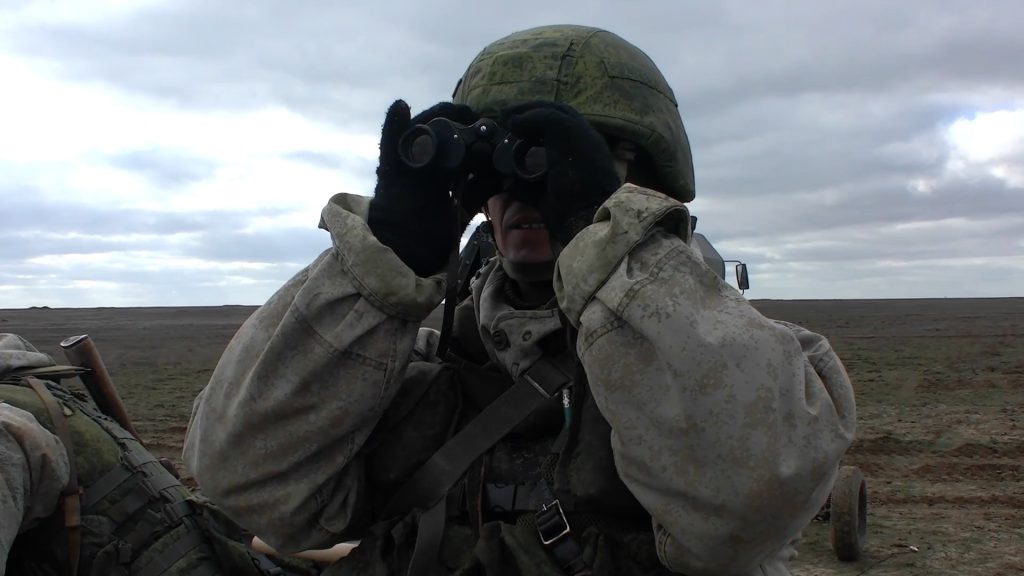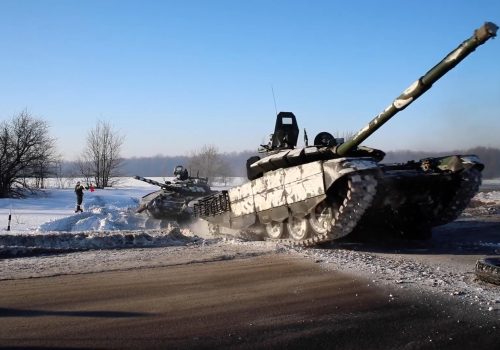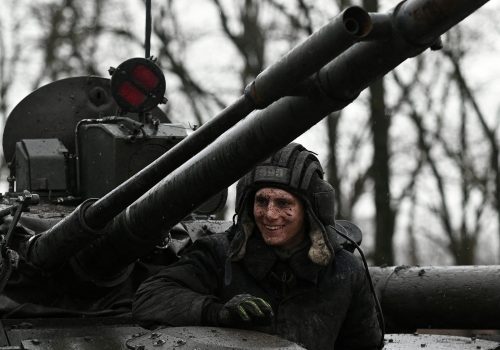In light of the ongoing Russia crisis, the Scowcroft Center’s Forward Defense (FD) practice will share weekly assessments of the latest force developments surrounding Ukraine, leveraging the expert perspectives of our senior military fellows. The opinions, conclusions, and recommendations expressed or implied here are solely those of the authors and do not necessarily represent the views of the Department of Defense or any other US government agency.
The bottom line
Russia has essentially completed preparations for a large-scale offensive operation and could likely execute a further invasion of Ukraine with less than twelve hours of unambiguous warning, such as fielded forces moving to their “jumping off” points. Its joint exercise with Belarus has focused on a combined arms offensive, including establishing air superiority and providing air support to a large, mechanized force. Russia’s upcoming naval exercises will likely focus on establishing naval superiority in the Black Sea, potentially leveraging its fleet to execute a naval embargo of Black Sea ports.
Russian force movements
Air and Air Defense: The Russian Air Force (RAF) has the aircraft in place to support a major offensive. The RAF is training to quickly establish air superiority over Ukraine and provide air support to ground forces, all while signaling that it will engage US or NATO aircraft should they intervene in the conflict.
- On February 10, Russian Su-25 aircraft performed a ground-attack mission as part of the Union Courage ‘22 exercise (also known as Allied Response ‘22). Notably, the Russian Ministry of Defense (MoD) stated that the Su-25s “performed combat training tasks to detect camouflaged objects simulating control points, armored and automotive equipment of the mock enemy.” This mission demonstrates the type of interdiction missions Su-25 and other ground-attack assets will be tasked with in conflict: finding and destroying enemy mechanized targets such as tanks and artillery before they are in close combat with Russian ground forces.
- On February 11, the Russian MoD announced that Su-35S fighters conducted a training mission in which they captured and destroyed a “conditional air target.” The press release noted that the “unified regional air defense system” of Russia and Belarus “discovered a conditional air target approaching the area of responsibility that did not respond to requests.” While a fighter aircraft simulation like this is routine, for Russia to publicize it in this way sends a message to the United States and NATO: If they fly an aircraft near or into an area of active hostilities, the Russians will destroy it. Moreover, the advanced fighter aircraft and surface-to-air missiles (SAM) Russia has deployed to Belarus provide the anti-access/area denial (A2/AD) “bubble” that covers much of the Ukrainian airspace—a further warning against any NATO nation entering Ukrainian airspace in the event of further hostilities.
Navy: Russian exercises off the coast of Ukraine and the presence of versatile submarines reduce the ability of Ukraine to sound the alarm at the first signs of imminent attack. Watch for movements to and from Black Sea ports as an indicator of danger nearby.
- On February 10, the Russian Black Sea Fleet began exercises off the coast of the Crimean Peninsula in the Sea of Azov. These exercises integrate naval forces into an A2/AD area on the Ukrainian coastline while simultaneously cutting off the port of Odesa. While not a blockade, these exercises can effectively achieve the same outcome. Additionally, the proximity to Ukraine’s coast significantly reduces the ability to signal warning prior to a Russian invasion. One potential indicator remains: The ships involved in any exercises prior to an invasion may conduct a quick port call to top off stores, extending the length of time the ships will remain on station. Look out for ships pulling into port for a few short hours before quickly returning to station.
- On February 13, a Russian improved Kilo-class submarine (Project 636.3) transited the Turkish straits into the Black Sea. Project 636.3 submarines are equipped with Kalibr missiles, providing a range of options from land attack to anti-ship. The arrival of an additional Kalibr-capable submarine increases Russia’s ability to covertly strike targets and hold NATO ships at risk with little to no warning.
Nuclear-Capable Forces: Russia’s latest moves with its nuclear-capable forces are likely intended to warn the United States and NATO countries of the risks of nuclear escalation should they intervene directly in support of Ukraine. These actions supplement statements from President Vladimir Putin and other top Russian officials about the risk of nuclear war. Russia does not need to transport any equipment to be capable of nuclear escalation in Europe, so these moves are best understood as signaling.
- On February 7, a hand-held video surfaced showing a MiG-31 equipped with a Kinzhal air-launched, hypersonic, ballistic missile landing in Kaliningrad, the Russian exclave bordering Poland and Lithuania, for the first time. According to Russia, the missile is nuclear capable and has a 1,250-mile range, meaning the MiG-31 could launch the missile from Kaliningrad airspace and easily reach multiple high-value targets in Ukraine, including the capital. The deployment means Russia is likely to operationally employ this hypersonic missile if Russia initiates a large-scale offensive, while also providing an implicit threat of possible nuclear retaliation against US and NATO intervention in a possible expanded Ukraine conflict.
- So far, there has been no appearance of some of the other so-called “exotic” nuclear weapons outlined by Putin in a 2018 speech, including a nuclear-powered, nuclear-armed cruise missile and a nuclear-powered, nuclear-armed submarine drone. It is possible that Russia is holding these in reserve for additional nuclear signaling. It may be more likely that these systems are not yet ready for prime time (recall that the Burevestnik cruise missile exploded after a 2019 test).
- The Kinzhal deployment dovetails with patrols of Russian Tu-22 nuclear-capable bombers over Belarus as we analyzed in our last assessment, as well as similar patrols in November and December of last year.
US, allied, and partner deployments
On February 12, the US Department of Defense (DoD) announced that the US Army will deploy three thousand more US soldiers to reinforce NATO countries in Eastern Europe. The United States has now deployed five thousand soldiers total to Europe and repositioned a Stryker Task Force (one thousand soldiers) from Germany to Romania. These additional ground forces will be ready to assist in evacuating US citizens who may flee into Poland during the crisis but, as US policy stands now, these troops will not enter Ukraine to evacuate personnel. The DoD’s current priority is avoiding US military casualties, versus conducting a classic non-combatant evacuation operation (NEO) with military personnel. Additionally, the DoD announced it was moving one hundred and sixty US soldiers out of Ukraine. They had been deployed to advise and mentor the Ukrainian military. If US troops are caught in the crossfire of a Russian invasion—even in an operation as peaceful as a NEO—it risks pulling the United States and NATO into a much broader conflict.
- Led by the Corps Commander, the three hundred soldiers from the XVIII Airborne Corps Headquarters who have already deployed to Germany could eventually be part of a Joint Task Force Headquarters formed to lead the US military tactical response in Ukraine.
- Several US-based units remain on heightened alert (a five-day versus ten-day deployment timeline). These units include combat formations, medical support, aviation support, and logistics support; they are drawn from the XVIII Airborne Corps, 82nd Airborne Division, 101st Airborne Division, and the 4th Infantry Division.
Over the past three weeks the US Air Force has deployed at least ten fighter and bomber aircraft from the continental United States to Europe and forward-deployed fighters from their home bases in Europe to Eastern Europe. Most visibly, the US Air Force sent four B-52 Stratofortresses to Royal Air Force Base (RAF) Fairford in the United Kingdom. Additionally, six F-15E Strike Eagles deployed from Seymour Johnson Air Force Base, North Carolina, to Estonia as part of the Baltic Air Policing mission. Finally, the US Air Force is pushing its Europe-based aircraft eastward, sending F-15C air-to-air fighters from RAF Lakenheath to Poland and sending F-16 Fighting Falcons from Spangdahlem Air Base in Germany to Romania. These deployments are designed to signal the United States’ resolve, demonstrate military strength, and signal the ability of the United States to gain air superiority if the potential conflict spills over beyond Ukraine.
FD’s conclusion
Russia has completed—or is very close to completing—its build-up of forces in Belarus and on its border with Ukraine. Its forces now include high-end military capabilities; combat enablers, such as intelligence, surveillance, and reconnaissance (ISR), electronic warfare, mobile communications, and command and control vehicles; and combat sustainment capabilities, including ammunition, vehicle maintenance, field medical sites, blood supplies, and security forces. The most likely indicator of imminent invasion will be the movement of deployed forces to “jumping off” positions, which may have already begun. Check out our military assessment map here.
Meet our military fellows
Today’s briefing is brought to you by senior US Army fellow COL Benjamin Johnson, senior US Navy fellow CDR Daniel Vardiman, senior US Air Force fellow Lt Col Tyson Wetzel, and FD assistant director Mark J. Massa. The Scowcroft Center Military Fellows Program, housed by the Forward Defense practice, hosts military fellows from participating branches of the US military and the armed forces of US allies and partners each year as part of a twelve-month fellowship program.
Further reading
Tue, Feb 15, 2022
Russian Hybrid Threats Report: Military camps close in on border as Kremlin accelerates false-flag narratives
New Atlanticist By
While the Kremlin announced that some units have begun loading equipment onto trains to return to their bases, the DFRLab continues to observe other units positioning themselves closer to Ukraine's northeast border with Russia.
Tue, Feb 8, 2022
US adversaries have been mastering hybrid warfare. It’s time to catch up.
Hybrid Conflict Project By Marc Polymeropoulos, Arun Iyer
Bad actors are embracing hybrid warfare. Time is of the essence for Washington to seize the advantage.
Wed, Feb 9, 2022
Russia Crisis Military Assessment: What would a ground offensive against Ukraine look like? Watch the skies.
New Atlanticist By
Our military experts analyze the greatest defense and security challenges facing the United States and its allies and partners.
Image: Russian artillery units conduct combat exercises in Russian-occupied Crimea in this footage released by the Russian defense ministry on February 14, 2022. Photo via REUTERS



